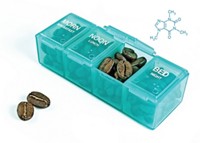Advertisement
Grab your lab coat. Let's get started
Welcome!
Welcome!
Create an account below to get 6 C&EN articles per month, receive newsletters and more - all free.
It seems this is your first time logging in online. Please enter the following information to continue.
As an ACS member you automatically get access to this site. All we need is few more details to create your reading experience.
Not you? Sign in with a different account.
Not you? Sign in with a different account.
ERROR 1
ERROR 1
ERROR 2
ERROR 2
ERROR 2
ERROR 2
ERROR 2
Password and Confirm password must match.
If you have an ACS member number, please enter it here so we can link this account to your membership. (optional)
ERROR 2
ACS values your privacy. By submitting your information, you are gaining access to C&EN and subscribing to our weekly newsletter. We use the information you provide to make your reading experience better, and we will never sell your data to third party members.
Biological Chemistry
Newscripts
Cures (Or Not) For What Ails You
by Kimberly Dunham
May 7, 2007
| A version of this story appeared in
Volume 85, Issue 19
Cures (Or Not) For What Ails You
Flying in the face of home remedies, a recent finding from researchers at the University of Minnesota and published in the Archives of Dermatology (2007, 143, 309), once and for all settles an oft-debated question about getting rid of warts: No, DUCT TAPE is not the answer. The Newscripts gang is going to take a moment to figure out how to break the news to the moms of the world.
Okay, with that done, let's talk more about warts. Just in case you don't know how duct tape is purported to cure warts, it has something to do with simply covering them—occlusion, in fancy wart-study terms—although the exact mechanism is not well-understood. Duct tape supporters believe this alleged remedy works because of a specific property of the tape—its rubber content, perhaps. Duct tape skeptics disagree, saying any other occlusion device, such as moleskin, can work just as well.
The University of Minnesota study pitted those two camps squarely against each other. Ninety adults with at least one wart measuring 2–15 mm (and perhaps longing for dates?) were asked to participate. The main outcome measure, according to the researchers, was "complete resolution of the target wart." Findings? Duct tape was not statistically different from moleskin for the treatment of warts. The study found that 21% of patients using duct tape experienced complete wart resolution, compared with 22% of moleskin-using participants.
Researchers have been thinking long and hard-though not too hard, lest they give themselves frown lines-about new uses for BOTOX. Now, doctors from Germany report in Lancet (2007, 369, 1372) that they have used botulinum toxin to cure palmar hyperhidrosis—otherwise known as excessive hand sweating. The doctors were rumored to have celebrated with dry high fives all around.
The patient in this case is a 23-year-old woman who experienced hyperhidrosis on her right hand and forearm. She suffered excessive, dripping sweat in these areas an average of five times per day for 30 minutes at a time. The doctors found that intradermal injections of the poison were able to resolve the embarrassing condition.
Curing excessive hand sweat with Botox sounds great to the Newscripts gang, who can be found sweating from time to time over tight deadlines. It makes us wonder, however, about additional benefits and downsides to the treatment. Although it could leave our palms looking smoother, perhaps even line-free, would it render our next palm-reading sessions inconclusive?
In the continuing effort to turn people into robots, one part at a time, a research consortium in the European Union, sponsored by the European Commission's Sixth Framework Program for Research & Technical Development, reports that it has created a drug delivery system contained in an electronic prosthetic TOOTH. A potential replacement for pills or injections, the so-called Intellidrug device, which is about the size of two molars, can be preprogrammed to deliver medication on a schedule and then loaded with the drug and implanted in a patient's mouth.
And who would benefit most from this cybertooth? The researchers say the device is intended for chronically ill patients tired of constantly swallowing pills or for patients who have dementia and can no longer remember to take their medications. Intellidrug is set to undergo clinical testing this year in trials involving Naltrexone, a medication prescribed to drug addicts undergoing withdrawal therapy.
This new device would certainly allow you to be armed to the teeth with medication. Could it take a bite out of your pain? Be fitted with Bluetooth technology? Either way, Intellidrug is certainly some new science to chew on. Okay, that's enough. We promise to bite our tongues from now on.
This week's column was written by Kimberly Dunham. Please send comments and suggestions to newscripts@acs.org.





Join the conversation
Contact the reporter
Submit a Letter to the Editor for publication
Engage with us on Twitter